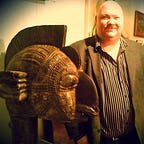I recently attended a Santeria ceremony where the Orisha Olokun was celebrated. The ritual focused on asking for abundance and health from the deity that is recognized as owning the deepest oceans and lagoons. Offerings of several foods were used in blessings for attendees and given as an offering to Olokun. The ritual was accompanied by beautiful songs and rhythmic movements. The ceremony culminated with many of the offerings placed in a basket and held above one of the initiates.
Olokun veneration is alive and well in 2021 but there is evidence of the deity’s worship in the 15th century. During the reign of King Ewuare in Benin, the king had a 6 mile long moat built around the city with the West of the city dedicated to Olokun. Legend says that the king attained his wealth after a visit to the underwater palace of Olokun made of cowrie shells. The king would go on to change the name of the city to Oba-Edo after a hero named Edo.
The people of Edo recognized Olokun as god of the sea and the chief deity of fishermen. Olokun is a powerful and benevolent deity that can create children and bring health and riches to those that worship the deity. One of the praise names given to Olokun translated to English means ‘The King of the sea is greater than the king of the land’. There is a legendary story involving a series of tests between Olokun and his father Osanobua. As a child Olokun proved to Osanobua the creator that he held the wisdom to control the universe. Osanobua decided to test Olokun by sending him out to the river to catch water in a woven reed basket. Olokun recognized his father’s trick and before he left for the river he painted several patterns on the ground in chalk. He asked the father to remove the diagrams if rain came and to keep them from dissolving. The father agreed and Olokun left for the river.
Knowing that the reed basket could not hold water Olokun decided to bathe in the river. Olokun caused a great rain storm to fall and wash away the design Osanobua was expected to protect. When he arrived home Osanobua asked Olokun “Where is my basket of water?” to which Olokun replied “Why didn’t you save my design?” Osanobua then confessed that it was impossible to separate the design from the land. Olokun then told his father that it was impossible to carry water in a reed basket. Impressed by his wisdom Osanobua gave Olokun the power to bring wealth, health and children into the world. As a result the Edo pray that “ A bie omo no se omwen e re Osanobua na bie Olokun’ or ‘Pray to have a child greater than yourself, that is why Osanobua had Olokun’.
In the 16th and 17th century images of pythons associated with Olokun began to appear in various pieces of art. Later discoveries of images of crocodiles as messengers of Olokun would appear. The crocodile would not only serve as messengers of the great deity but would also come to represent signifiers of chiefs coming into this land from the land of the ancestors.
Olokun is described as having black skin and long black hair. In the book The Yoruba Speaking People of the Slave Coast of West Africa originally published in 1894 the book speaks of Olokun’s wives who are the goddesses of the Lagos lagoon and the Lagos harbor. A story is recorded where Olokun was angered at humanity for neglecting his worship. Olokun wanted to destroy humanity with a great flood but was stopped when Obatala interfered. Obatala forced Olokun back to his palace and bound him with seven chains until he promised to give up his idea of destruction.
Olokun has appeared in many different forms among African cultures. In much of the Black Atlantic diaspora Olokun is mentioned in masculine terms but some communities in West Africa view Olokun as female.
Baba John Mason speaks to the deep metaphor that Olokun represents as he reminds us that “Olokun embodies the principle that there are certain things which are unknowable and this acts as a check on man’s possible arrogance”.
We need that check now more than ever…
Sources:
Royal Arts of Africa from Suzanne Blier
Engaging the Orisha: an Exploration of the Yoruba Concept of Ibeji and Olokun as Theoretical Principles in Black Theology from Marcus Louis Harvey
Chalk Iconography in Olokun Worship by Norma Rosen, African Arts May 1989, Vol.22, №3
The Yoruba Speaking Peoples of the Slave Coast of West Africa by A.B. Ellis
